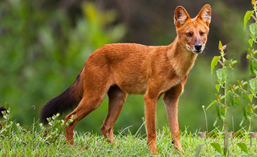

9th October 2023 (10 Topics)
Context
The study through camera traps in western Assam’s Manas National Park revealed that overlapping prey availability or habitat suitability could dictate a positive association between dholes and tigers, facilitating co-existence or even cooperative behaviours between the two species of carnivores.
Findings of the study:
- The study revealed that the diurnal activity of the dholes had the highest temporal overlap with leopards and the lowest with clouded leopards.
- Objective: The hypotheses included conflict with humans on the periphery of protected areas as the primary threat to dholes, higher habitat utilisation where small-medium prey species such as rodents, hares, and rhesus macaques, and a negative relationship between dhole habitat use and other large carnivores.
- The study was conducted to analyse, the sympatrids of Dhole population.
|
Sympatric refers to animals, plant species, and populations within the same or overlapping geographical areas. |
- The findings also revealed a surprising positive relationship between dhole habitat use and tiger, rejecting the habitat exclusivity hypothesis.
- This unexpected result challenges the assumption of antagonistic interactions between these two species and suggests a more complex ecological dynamic.
- The positive association could be attributed to factors such as overlapping prey availability or habitat suitability, which may facilitate co-existence or even cooperative behaviours between dholes and tigers.
About Dhole:

- Geographic Range: From the Altai Mountains in Manchuria in Central and Eastern Asia, its range spreads southwards through the forest tracts of India, Burma, and the Malayan Archipelago. Three races of the dhole exist in India alone.
- Habitat: Dholes like open spaces and can often be found on jungle roads, river beds, jungle clearings, and paths, where they rest during the day.
- The dhole is a highly social animal, living in large clans without rigid dominance hierarchies and containing multiple breeding females. Such clans usually consist of 12 individuals, but groups of over 40 are known.
- Conservation:
- The dhole is protected under Schedule 2 of the Wildlife Protection Act, 1972.
|
The creation of reserves under Project Tiger provided some protection for dhole populations sympatric with tigers. |
- In 2014, the Indian government sanctioned its first dhole conservation breeding centre at the Indira Gandhi Zoological Park (IGZP) in Visakhapatnam.
- The global population of adult dholes, now classified as endangered on the International Union for Conservation of Nature’s Red List, is estimated to be between 949 and 2,215 individuals, scattered in localised areas of India and Thailand.
- Threats: Factors contributing to this decline include habitat loss, loss of prey, and competition with other species, persecution, and disease transfer from domestic dogs.

